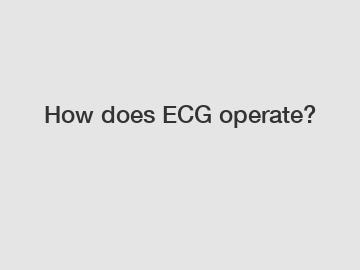How does ECG operate?
How does ECG operate?
Electrocardiography, commonly known as ECG or EKG, is a widely used medical test that helps healthcare providers assess the electrical activity of the heart. This non-invasive procedure is crucial in diagnosing various heart conditions, making it an indispensable tool in cardiology. In this article, we will explore how ECG operates, discussing the process, equipment used, and its significance in diagnosing heart disorders.
The Process:

An ECG test involves the placement of electrodes on the patient's skin. These electrodes detect and transmit the electrical signals generated by the heart to a machine, which then displays the information graphically on a monitor or paper. To ensure accurate results, the patient needs to lie still during the procedure and may be asked to hold their breath temporarily.
The Equipment:
1. Electrodes: These small, adhesive patches are attached to specific locations on the patient's chest, arms, and legs. They act as sensors to pick up the heart's electrical activity.
2. ECG Machine: The ECG machine receives the electrical signals from the electrodes and converts them into a graphical representation. Modern ECG machines are computerized and provide enhanced analysis capabilities.
3. Leads: The electrodes are connected to the machine through leads or cables. The number of leads used can vary depending on the type of ECG being performed.
Significance in Diagnosing Heart Disorders:
1. Detecting Arrhythmias: ECG is primarily used to identify abnormal heart rhythms or arrhythmias. These irregular electrical patterns may indicate heart conditions such as atrial fibrillation, bradycardia, or tachycardia.
2. Assessing Heart Damage: ECG provides valuable insights into past or ongoing heart damage. It can help diagnose conditions like myocardial infarction (heart attack) or ischemia (inadequate blood flow to the heart muscles).
3. Monitoring Treatment Effectiveness: For patients with known heart conditions, regular ECG tests can monitor the effectiveness of prescribed medications or procedures.
4. Risk Assessment: ECG is often utilized to assess the risk of developing heart diseases. By analyzing the electrical activity of the heart, healthcare providers can identify potential risk factors and take preventive measures accordingly.
Closing paragraph:
In conclusion, electrocardiography plays a critical role in diagnosing heart disorders by assessing the heart's electrical activity. The procedure involves placing electrodes on specific areas of the body, which are then connected to an ECG machine. This machine translates the electrical signals into graphical representations for analysis. ECG is essential in detecting arrhythmias, assessing heart damage, monitoring treatment effectiveness, and evaluating the risk of developing heart diseases. If you have any further questions about ECG or would like to schedule a test, please don't hesitate to contact us.
The company is the world’s best smartwatch features and benefits, OEM ODM fitness tracker manufacturer, smart watch manufacture supplier. We are your one-stop shop for all needs. Our staff are highly-specialized and will help you find the product you need.


